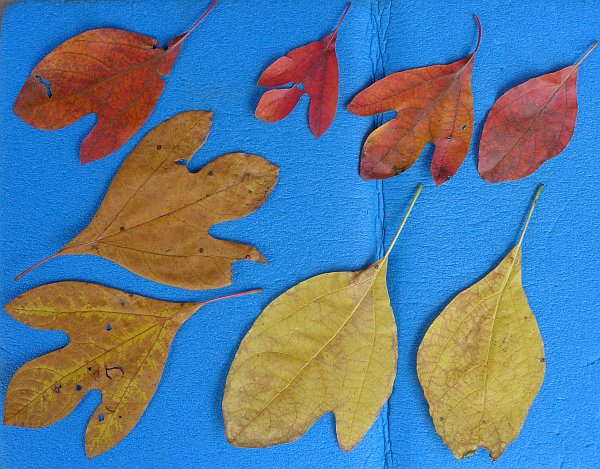
These very different leaves came from the same tree.
Sassafras turns red and yellow in the fall showing off its unlobed leaves, two-lobed “mittens” and three-lobed “paws.” All three shapes grow on the same tree including both right and left-handed mittens (I checked).
Sassafras (Sassafras albidum) is a medium-sized tree native to eastern North America from southern Maine to Florida to eastern Texas. In Pennsylvania it grows everywhere except on the central high plateau of the Northern Tier.
The tree’s roots, bark, shoots and fruit were used directly in many foods, drinks, perfumes and medicines (think “root beer”) until the essential oil, safrole, was discovered to be carcinogenic and outlawed by the FDA in 1960. Sassafras by-products can still be used in food and cosmetics as long as they’re certified safrole-free. Safrole is used in pesticides.
In Europe people plant sassafras as an ornamental for its aromatic scent and unusual leaves.
I found these in the wild in Harrison Hills County Park.
(photo by Kate St. John)
As children, we chewed on the leaf stems – guess that wasn’t a good idea!
One of my favorite trees… the 2 places we’ve lived previously have both had sassafras trees on them, but I don’t think our current property has any. Perhaps I will plant some to replace the ash trees that are being killed by the borer 🙁
During spring and summer when you pluck a leaf and smell the stem it has a citrus smell!
Sassafras wood looks very similar to oak and is softer and more affordable than oak. Makes very pretty furniture.
Beautiful colors in fall. Interesting shaped tree.
Definitely not dangerous.
So many benefits from the plant, so the FDA outlawed it.
Luke Metz, the long ago toxicity determination is complicated by newer findings https://en.wikipedia.org/wiki/Safrole#Toxicity
There is another tree in the Maryland area – not a Sassafras tree – which has all four shapes of leaves. It have a very fuzzy surface and is rarely used as a thing of beauty. Does anyone have any idea of it’s proper name?
Thanks